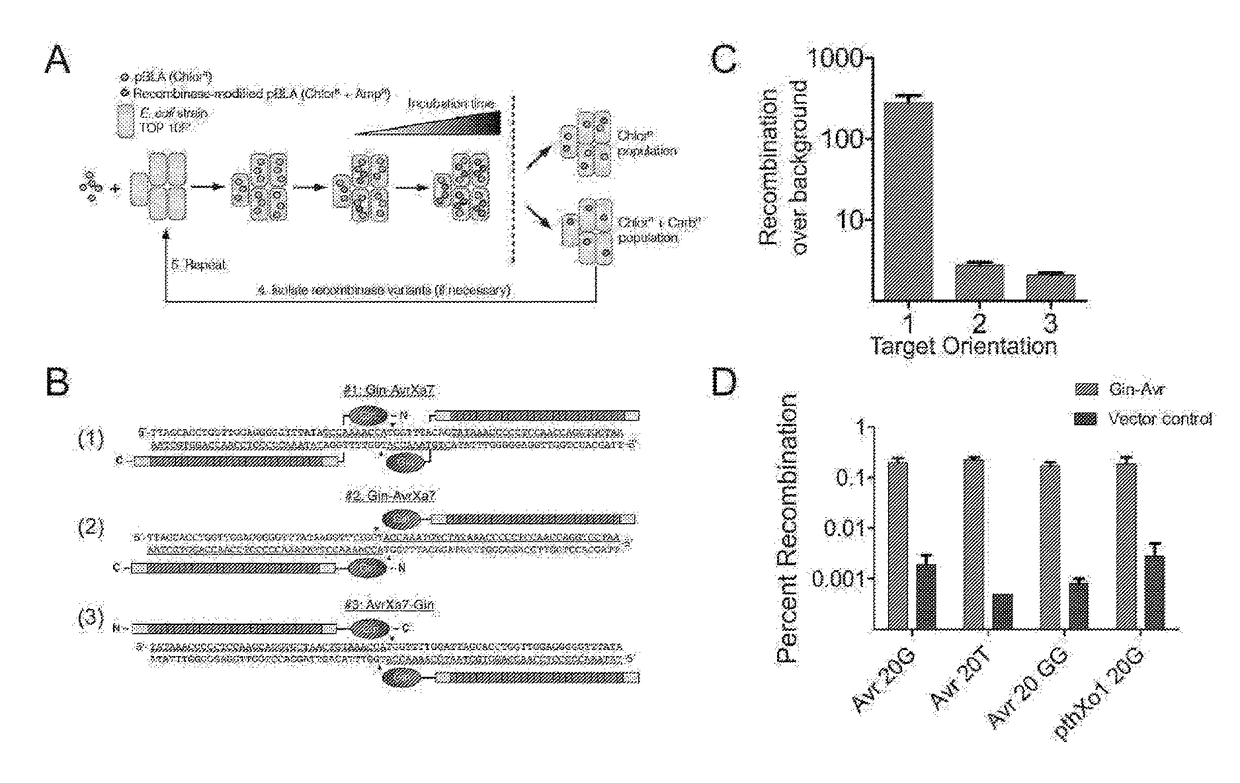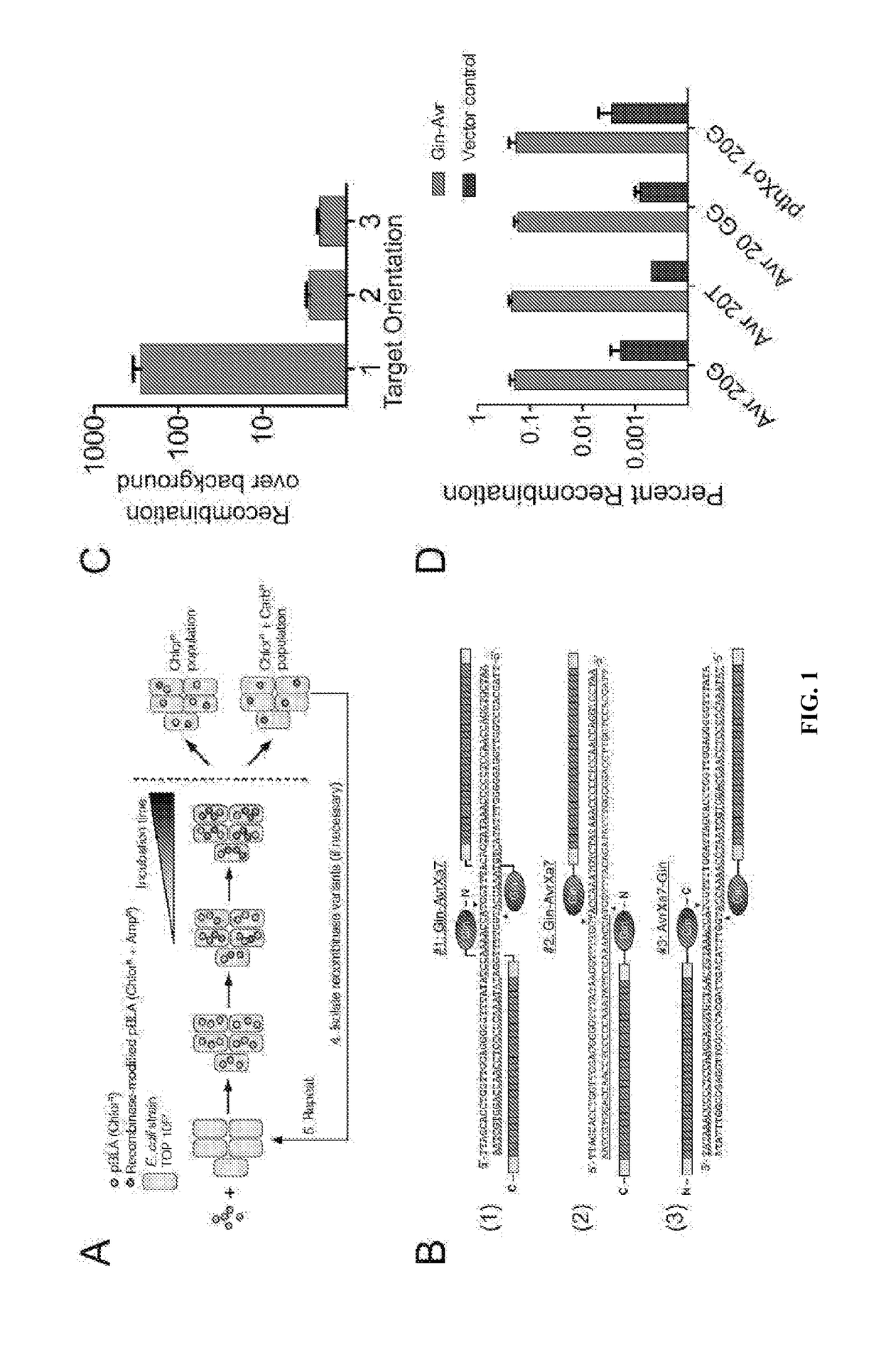Chimeric polypeptides having targeted binding specificity
a polypeptide and specificity technology, applied in the field of biotechnology, can solve the problems of difficult detection of off-target cleavage events, difficult construction of specific sequences, and difficulty in high-affinity zfps for certain sequences, and achieve the effect of improving activity
- Summary
- Abstract
- Description
- Claims
- Application Information
AI Technical Summary
Benefits of technology
Problems solved by technology
Method used
Image
Examples
example 1
Chimeric Tale Recombinases
[0145]Experimental Summary.
[0146]This study provides the first example of a TALE recombinase (TALER). Using a library of incrementally truncated TALE domains, an optimized TALER architecture was identified that can be used to recombine DNA in bacterial and mammalian cells. Any customized TALE repeat array can be inserted into the TALER architecture described herein, thus dramatically expanding the targeting capacity of engineered recombinases for applications in biotechnology and medicine.
[0147]The following Material and Methods were utilized in this Example.
[0148]Reagents.
[0149]All enzymes were purchased from New England BioLabs unless otherwise indicated. Primer sequences are provided in Table 4.
[0150]
TABLE 4Primers.Primers used in this studyPrimers for pBLA substrate constructionAvrXa7 lac target FSEQ ID NO: 148TTAATTAAGAGTCTAGAAATATAAACCCCCTCCAACCAGGTGCTAACTGTAAACCATGGTTTTGGATTAGCACCTGGTTGGAGGGGGTTTATAAGATCTAGGAGGAATTTAAAATGAGAvrXa7 lac target RSEQ ID N...
example 2
Selection of Novel 0th Residue Specificity
[0196]A new class of Tal-based DNA binding proteins was engineered. TAL (transcription activator-like) effectors constitute a novel class of DNA-binding proteins with predictable specificity. Tal effectors are employed by Gram-negative plant-pathogenic bacteria of the genus Xanthomonas which translocate a cocktail of different effector proteins via a type III secretion system (T3SS) into plant cells where they serve as virulence determinants. DNA-binding specificity of TALs is determined by a central domain of tandem repeats. Each repeat confers recognition of one base pair (bp) in the DNA. Rearrangement of repeat modules allows design of proteins with desired DNA-binding specificities with certain important limitations. For example, the most constraining feature of targeting a DNA sequence with a Tal domain is the requirement that the Tal DNA site start with the base T and sometimes C. Targeting a binding site starting with a G or A base ha...
example 3
Selections
[0200]For context dependent RVD selections and selections of RVDs with new specificities, libraries were created that randomize the HD sequence emboldened below.
[0201]
(prototype RVD sequence; SEQ ID NO: 225)LTPDQVVAIASHDGGKQALETVQRLLPVLCQDHG
[0202]Typically the library allows all amino acids at these two positions, though libraries limited to N, D, H, K, and Q amino acids are often successful substitutes for the H residue. Alternatively larger libraries that randomized the SHDG (SEQ ID NO: 226) and ASHDGG (SEQ ID NO: 227) regions allow for the selection of unique RVD specificities with context dependent characteristics.
[0203]Tal recombinase activity selections then rapidly allow for the selection of new specificities within the targeted RVD domain. The resulting RVDs can be highly modular or context dependent in their sequence recognition and can be then used to create Tal nucleases and transcription factors.
[0204]Utility of this technology includes unrestricted approaches ...
PUM
 Login to View More
Login to View More Abstract
Description
Claims
Application Information
 Login to View More
Login to View More - R&D
- Intellectual Property
- Life Sciences
- Materials
- Tech Scout
- Unparalleled Data Quality
- Higher Quality Content
- 60% Fewer Hallucinations
Browse by: Latest US Patents, China's latest patents, Technical Efficacy Thesaurus, Application Domain, Technology Topic, Popular Technical Reports.
© 2025 PatSnap. All rights reserved.Legal|Privacy policy|Modern Slavery Act Transparency Statement|Sitemap|About US| Contact US: help@patsnap.com



